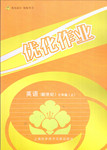题目内容
---What did your mother say on the phone just now?
--- She asked me _____ I was getting on well with my new classmates.
| A.that | B.if | C.how | D.what |
B
解析

 培优三好生系列答案
培优三好生系列答案 优化作业上海科技文献出版社系列答案
优化作业上海科技文献出版社系列答案Three armed robbers stole two Pablo Picasso prints from an art museum in downtown Sao
Paulo on Thursday, which was the city’s second high-profile art theft in less than a year. The bandits also took two oil paintings by well-know Brazilian artists Emiliano Di Cavalcanti and Lasar Segall, said Carla Regina, a spokeswoman for the Pinacoteca do Estado museum.
The Picasso prints stolen were "The Painter and the Model" from 1963 and "Minotaur, Drinker and Women" from 1933, according to a statement from the Sao Paulo Secretary of State for Culture, which oversees the museum. The prints and paintings have a combined value of $612,000, the statement and a museum official said.
About noon, three armed men paid the $2.45 entrance fee and immediately went to the second-floor gallery where the works were being exhibited, bypassing more valuable pieces, authorities said. "This indicates to us that they probably received an order" to take those specific works, Youssef Abou Chain, head of Sao Paulo's organized crime unit, told reporters at a news conference. The assailants overpowered three unarmed museum guards and grabbed the works, officials said. The robbery took about 10 minutes and the museum was nearly empty at the time. The assailants took the pieces — frames and all — out of the museum in two bags. The institution has no metal detectors.
In December, Picasso's "Portrait of Suzanne Bloch" and "O Lavrador de Cafe" by Candido Portinari, an influential Brazilian artist, were stolen from the Sao Paulo Museum of Art by three men who used a crowbar(铁撬棍)and car jack to force open one of the museum's steel doors. The framed paintings were found Jan. 8, covered in plastic and leaning against a wall in a house on the outskirts of Sao Paulo, South America's largest city. One of the suspects in that robbery — a former TV chef — turned himself over to police in January, who already had two suspects in custody(监禁).
【小题1】What did the armed men steal on Thursday?
| A.Two prints by Pablo Picasso |
| B.Two oil painting by Brazilian artists |
| C.Two prints by Pablo Picasso and two oil paintings by two Brazilian artists. |
| D.Two prints by two Brazilian artists and two oil paintings by Picasso Pablo. |
| A.Because they didn't know that the other pieces were worth more. |
| B.Probably because they had received an order for the prints that they took. |
| C.Because they didn't have enough time. |
| D.Because they were in such a hurry that they couldn’t get them all. |
| A.A lot. The museum was crowded. |
| B.Not too many. It was almost empty. |
| C.There were a lot of people outside the museum. |
| D.Only three of them. |
| A.In December, "Portrait of Suzanne Bloch" and "O Lavrador de Cafe" painted by Candido Portinari were stolen. |
| B.There are steel doors and no detectors in Sao Paulo Museum of Art. |
| C.Three robbers defeated three armed museum guards and took away the works on Thursday. |
| D.Three suspects in the first high-profile art theft in less than a year were arrested. |
D
I shall never forget the night, a few years ago, when Marion J. Douglas was a student in one of my adult-education classes. He told us how tragedy had struck at his home, not once, but twice. The first time he had lost his five-year-old daughter. He and his wife thought they couldn’t bear that first loss; but, as he said, “Ten months later, God gave us another little girl and she died in five days.”
This double bereavement was almost too much to bear. “I couldn’t take it,” this father told us. “I couldn’t sleep, eat, rest or relax. My nerves were entirely shaken and my confidence gone.” At last he went to the doctors; one recommended sleeping pills and another recommended a trip, but neither helped. He said, “My body felt as if it was surrounded in a vice(大钳子), and the jaws of the vice were being drawn tighter and tighter.” The tension of grief(悲伤) — if you have ever been paralyzed(使瘫痪) by sorrow, you know what the meant.
“But thank God, I had one child left — a four-year-old son. He gave me the solution to the problem. One afternoon as I sat around feeling sorry for myself, he asked, ‘Daddy, will you build a boat for me?’ I was in no mood to build a boat; in fact, I was in no mood to do anything. But my son is a persistent fellow! I had to gave in. Building that toy boat took me about three hours. By the time it was finished, I realized that those three hours spent building that boat were first hours of mental relaxation and peace that I had had in months! I realized that it is difficult to worry while you are busy doing something that requires planning and thinking. In my case, building the boat had knocked worry out of the ring. So I determined to keep busy.”
“The following night, I made a list of jobs that ought to be done. Scores of items needed to be repaired. Amazingly, I had made a list of 242 items that needed attention. During the last two years I have completed most of them. I am busy now that I have no time for worry.”
No time for worry! That is exactly what Winston Churchill said when he was working eighteen hours a day at the height of the war. When he was asked if he worried about his huge responsibilities, he said, “I am too busy. I have no time for worry.”
53. The underlined word “bereavement” in the second paragraph refers to _____.
| A. having lost a loved one | B. having lost a valuable article |
| C. having lost a profit-making business | D. having lost a well-paid job |

| A. he couldn’t earn enough money to support his family |
| B. he was suffering from sleeplessness disease |
| C. he couldn’t get out of mental pressure |
| D. he felt tired of adult-education classes |

A. he hadn’t been able to spare time to mend them
B. he wanted to kill his free time by repairing them
C. the items had actually been broken and needed attention
D. repairing the items helped crowd worry out of his mind
56. At the end of the passage, the author wrote about Winston Churchill in order to _____.

A. prove that he followed Churchill’s example
B. support his student’s solution to his problem
C. show that he was successful in his career
D. make it clear how his conclusion was reached
People can enjoy visiting some major imperial temples (帝王庙宇) where emperors worshipped nature on various sacred days?
Temple of Moon (Yuetan)
Built in 1530,the roughly 8 hectare Temple of Moon,or Yuetan Park,to west of the imperial city was the site of imperial sacrifices to the moon.
In the past decades, bushes and fruit trees have been planted here.In 1969,a 180 meter--all television broadcasting tower was erected in the park,taking up about one eighth of its total space?
Opening hours:6 am~9 pm
Location:6 Yuetan Beijie,Xicheng District.Buses to get there:15,19,823.
Temple of Earth (Ditan)
The Temple of Earth,or Ditan Park,near the North Second Ring Road,is where emperors prayed to the earth for favorable weather and national prosperity.Built during the Ming Dynasty in 1 530,it is the only existing place to worship the earth.
The surrounding areas have become an open space for people to engage in leisurely activities.Since the late 1980s,traditional temple fair have been held here regularly during the Chinese lunar new year.
Opening hours:6 am~9 pm
Location:A2 D i’anmenwai,Chaoyang District.Buses to get there: 104,108,116,or take the subway to get off at Yonghegong to go north.
i’anmenwai,Chaoyang District.Buses to get there: 104,108,116,or take the subway to get off at Yonghegong to go north.
Temple of Sun (Ritan)
The Temple of Sun,or Ritan Park,in eastern Beijing,is located near the Jianguomen area and adjacent(邻近的) embassy district.It is a short walk from the Yong'anli subway station on the Line 1.The altar (祭坛) was built in l530 as a place for emperors to make ritual sacrifices to the sun.
It features expansive gardens and a small lake.A mural (壁画)wall, the park’s main scenic attraction now,was a piece of artwork created about 20 years ago to draw more sightseers.The park is also known for its blossoming lotuses.
Opening hours:6 am~9 pm
Location:6 Ritan Beilu,Chaoyang District.Buses to get there:1,4,28,43,57.120.
【小题1】What kind of people is the text mainly written for?
| A.Parents. | B.Students. | C.Tourists. | D.Teachers- |
of Sun
| A.19 | B.104 | C.108 | D.120 |
| A.Yuetan Park | B.Ditan Park | C.Ritan Park | D.Beilu Park |
| A.defend the park | B.prevent people from coming into the park |
| C.attract more sightseers | D.make ritual sacrifices to the sun |